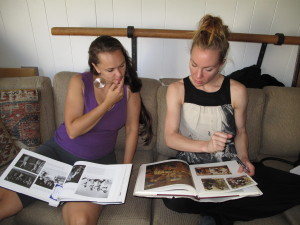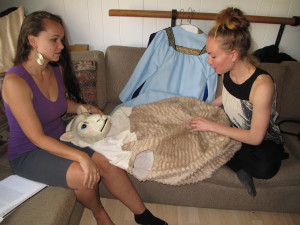MAKING HISTORIC COSTUMES for the theater can toss a designer way back in time, but for dancer-designer Jamielyn Duggan it was a quantum leap to 166 BCE for The Jewish Nutcracker, the novel twist to E.T.A. Hoffman’s story using Tchaikovsky’s score, and now in its fourth year.

Photo by Tom Carter
The Jewish Nutcracker embraces the Russian’s iconic music but that’s all. It creates a lively Hanukkuh party instead of a Christmas bash. It subs in a history-spinning godfather for Drosselmeyer. And his tales fill the head of Clara’s sub, Miriam, a pouting, doubting teenager, who dreams bigtime after the party. It’s about what her godfather said about the Festival of Light and the rebelling Maccabees led by the young hero Judah, defeating the oppressive Greek army to restore their Jewish temple—in 166 BCE.
No mouse king here, just gritty peasants rising up for their religious freedom against sword-weilding, red-caped soldiers.
The production is the brainchild of dancer-choreographer Katy Alaniz Rous, a former student at San Francisco Ballet as was Duggan. Both are multi-year veterans of SFB’s Nutcracker.
Duggan is a freelance designer and dancer when not performing with the San Francisco Opera Ballet corps, and Rous teaches and performs.
“It was a little daunting when Katy and I reconnected and she asked me to design the entire production,” Duggan says, recalling the assignment four years ago. “Nutcracker? That’s a lot of people. But it was going to happen and she wanted me. I instantly fell in love with the concept. I wanted to be in on a good thing. And I’m not even Jewish.”
Duggan’s first costume design job came when performing with Liss Fain Dance in 2006. Knowing her ambitions, the director asked Duggan to make “meditative and lovely” outfits for the three-scene, When Still. Even if the dancers moved to Gregorian chants, the directive resonated.
“Rich jewel tones—royal blue, burgundy, purple and gauzy, ethereal,” Duggan says. “I took a balletic approach—what I’d want to see the San Francisco Ballet wearing.” Her work got an Izzie (Isadora Duncan Dance Award) design nomination in 2007. Her clients since have included Amy Seiwert’s Imagery, LINES/BFA, ODC/Dance, BANDALOOP and others.
In The Jewish Nutcracker’s first year, Rous had already lined up Russian character, Indian Kathak and some other costumes for the show’s second half. Like the original Nutcracker, different countries are represented, but in cultural dance instead of ballet.
In the first act’s contemporary party scene, performers pick their costumes from their own wardrobes.
“Whoa, I thought…. 15 people already dressed, then I don’t have to do everything by hand,” Duggan says. “We went with the feeling it was the first year and we’ll just do the best we can knowing we can make improvements later.”
The mystery of Greek armor and 166 BCE Jewish peasant robes were the tip of the iceberg for a cast of 40. For soldiers, Duggan and Rous agreed on store-bought, plastic gold armor and helmets, short black skirts and spandex undies, red capes, bare feet. Cheap maybe, still these costumes put a dent in a tight budget then consisting only of donations to Rous’ nonprofit, the presenter World Dance Fusion.
“Google Greek soldiers and you’ll get someone else’s interpretation,” Duggan says. “Historical accuracy is important, yes, but so is being able to move a lot in the costumes and make quick changes,” which The Jewish Nutcracker soldiers do.
“And plastic for soldiers? Not ideal. Does it work? Yes. But the audience will be closer this time and I feel obligated to make it more real.”
The first row at the 170-seat Children’s Creativity Museum Theater near Moscone Center is about five feet from the stage, same level. The show’s premier was on the Jewish Community Center stage and the next two years were at ODC Theater.
“The first three years the biggest challenge was the Maccabees,” Duggan says. “There was no way of knowing exactly what a Maccabee looked like. I wanted to use stripes on robes as motifs. But I didn’t want it to look like a parody. It’s a biblical-times story I had to represent with historical accuracy.”
Biblical dress for peasants, she found, was not a coat of many colors.
“It’s typically taupe, and kind of boring. Through research it seemed blue was in the culture—maybe dyed with blueberries. It seemed to strike a balance in accuracy and visual interest.”
A good source among tomes they study is the 458-page Seeing Israel and Jewish Dance. Blue, silver and gold are typical colors in Jewish history.
Duggan made a practical choice. And the Maccabees, a Jewish tribe, have been wearing 12 reconstructed, polyester choir gowns that she ordered online.
Costumes in the second half reflect the cultures of Spain, Arabia, China, Russia, India and Italy.
Some dancers, like the two Russian girls last year, wore their colorful, well-designed dresses from another company. Dancer Farima Berenji reached into her pocket to redesign her Persian-style costume in her role imitating the Sugar Plum Fairy’s. In a second cast, Laura Bernasconi danced the role. This year, Duggan steps into the role of the Sufganiyot Fairy, as it is called in The Jewish Nutcracker. (Sufganiyot is a jelly-filled, powered-sugar doughnut served during Hanukkah.)
The Chinese dancers costumes wear Chinatown pajamas, “simple, yet effective,” Duggan says.
In another piece, a half dozen flower girl costumes were “deceptively simple.” Each dancer wore a green leotard, two chiffon skirts and wrist scarves. The head pieces were the uniting highpoint. Each was a three-petal, malleable wire flower that flared in rich color. It took Duggan an hour to anchor each to a small comb then sew them into green, organza headwraps.
“Each flower cost a dollar at the dollar store!” Duggan says like she’s won a prize. “This is what makes a costume, rather than something off the rack.”

Photo by Tom Carter
The sheep that cross the stage in the first act will have real sheepskin this year. In the 2012 production, three kids appeared as sheep. They wore numbly, tan cotton, cocoon-pajamas and strap-on, plastic sheep headpieces with soulful, large eyes. The kids crawled across the stage on black socks covering their hands and didn’t always see that well.
A woman in the audience last year humorously recalled that when the sheep accidentally jammed up at mid-stage one appeared to mount another.
Ironically, Duggan found the irresistible sheep masks at the Childrens Creativity Museum shop, right next to the theater where The Jewish Nutcracker will perform December 6-8. And the sheep leaped into the script.
“Who knew I was going to make children into sheep?” Duggan asks. “The kids really relate to it. And now the sheep faces will come full circle.”
Rous says many children from the party scene last year want the sheep roles. The flock is sure to grow. Duggan has a large sheepskin she has been saving for years. It can be cut into four panels.
The old sheep-jammies could become underbellies.
“The color will read well,” Duggan says.
“We need to cut the eyeholes bigger,” Rous says.
But the Maccabees have been the main focus of this year’s update, with historic accuracy paramount. They will need new head coverings, ditching the improvised tied rags that hid long hair of the women playing men in pants roles. This year turbans are in order.
“The color palette will stay— not too baby blue,” Duggan says. The light blue polyester choir robes will be replaced with breathable cotton, adorned variously at the neck, shoulders and arms with stripes lifted off the old garments.
The material will be $10 to $15 a yard, Duggan says. Each robe needs three to four yards and they’ll make 10. That could be a $600 hit to a budget that’s staying the same.
“The contrast on stage will be the soldiers dressed in red and the Maccabees in blue—easy to see” Rous says. The pants underneath are a practical choice—salwar, the Indian, drawstring kind, loose at the ankles and long where it counts.
“We had some ripped out crotches last year,” Rous says, “from high kicks.”
Undecided was the best way to keep removable talit (prayer shawls) on robes while dancing.
The Greek soldiers will also get an upgrade. Duggan was checking the costumes in September to see what was salvageable, or if starting from scratch was best.
“Even subtle things need consideration, like wearing no black spandex under the soldier’s skirts. I’ve got more time this year and I’ll get nit-picky to push it up a notch.
“We came out of the gates strong, but now it’s time to make it better.”
World Dance Fusion presents The Jewish Nutcracker, Fri-Sun, Dec 6-8, five performances: 3 matinees, 2 evenings, at the Children’s Creativity Museum Theater, 221 Fifth St, SF, Purchase tickets at jewishnutcracker.com
This article appeared in the November 2013 issue of In Dance.

